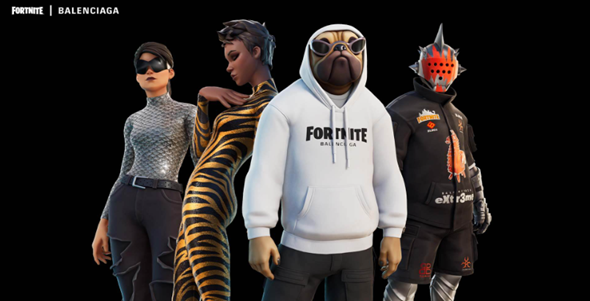Fashion in video games
The growing role of fashion in the world of video games was confirmed by the Roblox report published in November 2023 analysing the behaviour of Gen Z. The survey found that for 84% of respondents, digital fashion is an important part of the game, with 56% of respondents admitting that their avatar’s appearance is just as important to them as their own real-life appearance—up from 42% the year before.
165 billion modifications
In 2023, users of the Roblox gaming platform performed nearly 165 billion modifications to their avatars’ appearance, personalising them by changing their clothes, hairstyles, facial features, and accessories such as hats, glasses and jewellery. For this purpose, they purchased some 1.6 billion digital items, up 15% from the previous year. One example is the avatar’s makeup. More than a third of all respondents (35%) claimed that it is important for them to adjust their avatar’s makeup daily or weekly, a figure that rose to 51% for female gamers. Not surprisingly, many brands such as Fenty Beauty, Maybelline, NARS, Givenchy Beauty, NYX and L’Oreal have established cooperation with the Roblox platform to offer virtual versions of their products and allow players to personalise their avatars with these features.
According to the report, 52% of Gen Z gamers are willing to spend up to USD 10 per month on digital fashion items, 19% up to USD 20, and for 18%, between USD 50 and 100 per month.
Among Gen Z, 54% admit that their lifestyles are strongly inspired by those of their avatars, and 84% of respondents said they were more likely to buy a branded item in real life after trying the item on an avatar.
The increase in the purchases of digital items and the personalisation of avatars’ appearance also points to a growing need for gamers to express themselves through fashion in the virtual world. This demonstrates the power of advertising in games and its potential impact on purchasing decisions made in the real world. For fashion brands, this means an opportunity to build a strong relationship with customers and generate sales growth through virtual product exposure. In turn, for the game development industry, cooperation with fashion brands opens up the possibility of introducing exciting personalisation options for players, generating additional revenue through the sale of virtual items and raising the prestige of the game due to cooperation with renowned fashion brands.
Branded zones in the game
Collaboration often consists in designing clothes, accessories and “skins” for avatars from the game world. Often brands engage in creating dedicated worlds or boards in the virtual world. Collaborations also give players a chance to obtain physical products, such as exclusive, limited-edition clothes featured in the game.
The Sims × Moschino
In 2019, Moschino entered into a collaboration with Electronic Arts for the game The Sims. The fashion house created a special collection of clothes and furniture that could be used in this popular life simulator. This innovative concept allowed players to bring elements of real fashion into their virtual world. Some of the products from the game could be purchased in Moschino’s brick-and-mortar boutiques.

Source: https://www.ea.com/pl-pl/games/the-sims/news/moschino-collection
Fortnite x Balenciaga
In 2022, the Balenciaga fashion house entered into cooperation with the publisher of the popular Fortnite game. This collaboration included launch of both digital and physical collections of clothing, shoes and accessories. Fortnite engaged its players even further by allowing them to express their style and dress their avatars in Balenciaga’s latest collection on billboards in the dedicated game world. To participate in the contest, the players shared their avatars’ photos on Twitter (among other venues) using the hashtag #Fortography. Subsequently, the publisher selected the top avatar photos for placement on billboards in the virtual world.

Source: https://www.fortnite.com/news/high-digital-fashion-drops-into-fortnite-with-balenciaga
Animal Crossing x H&M
In 2021, the Swedish clothing giant H&M launched a collaboration with the Animal Crossing game, releasing a collection of creature-friendly and vegan clothes, presented at a virtual fashion show. The collection added to the existing Loop Island, a virtual place in the game that H&M created along with the publisher. Interestingly, players could return their “used” digital clothes to exchange them for new ones, just as they do at H&M’s brick-and-mortar stores.

Source: https://about.hm.com/news/general-news-2021/h-m-debuts-a-virtual-all-vegan-collection-and-fashion-show-in-an.html
Roblox x Gucci
In 2022, Gucci partnered with the Roblox platform to create the digital Gucci Town. Players could participate in themed games where they learned about the history of the Gucci fashion house, among other content. Players were also invited to visit a popup Gucci digital boutique.

Source: https://www.gucci.com/us/en/st/stories/article/gucci-town-on-roblox
Minecraft x Burberry
In 2022, Burberry started a collaboration with the Swedish publisher of the online game Minecraft. Players could buy special skins designed by Burberry for their characters and explore the world created by the brand in the Minecraft world. Burberry took the next step of introducing the collection to its brick-and-mortar stores, where the players could purchase clothes identical to those worn by their avatars in the game.

Source: https://row.burberry.com/c/collaborations/minecraft-burberry-partnership/
The legal angle?
As the video game market continues to grow, fashion brands will no doubt want to keep exploiting the potential of this market and the opportunity to advertise products to an ever-growing community of gamers.
A need for strong contracts
Collaboration between fashion brands and game developers and publishers raises a number of intellectual property issues. Such cooperation must be carefully regulated in the parties’ agreement to ensure smooth implementation of the project.
Clothes, shoes or fashion accessories from the real world can be considered “works” for purposes of copyright law if they meet the criteria of originality and individuality. Clothing designed for the digital world can also be considered copyrighted works. In any case, the parties should ensure proper licensing allowing clothes from the real world to be used in the virtual world and vice versa. This will involve specification of the fields of exploitation, i.e. where the licensee can use the work.
The name and logo of a fashion brand are often registered as trademarks. Trademark use is another issue that must be regulated. The brand must license the game manufacturer to use its trademarks in the virtual world, while the game manufacturer must license the brand to use its trademarks in the real world. It is similar with industrial designs.
Licences can be exclusive or non-exclusive. This choice will invoke different legal regimes. An exclusive licence for copyright or industrial property (e.g. a trademark or a Community design) must be granted in writing for it to be invalid. In addition to the correct form, it is essential to correctly define the subject of the agreement.
The area where licence is valid is also crucial. If the area is not specified, it is presumed that the licence covers only the licensee’s jurisdiction, which is particularly relevant in light of the global nature of video games.
Additional obligations and restrictions relevant to the fashion brand and the game publisher may also be included in the licence agreement. For example, there may be specific conditions for how in-game characters can be presented in a particular outfit so that the brand’s image is adequately protected. This may include restrictions on the context in which clothes are used in the game. Additionally, the agreement may require the clothes to be presented in high-quality graphics, ensuring that the details and aesthetics of the products are faithfully reflected in the virtual world (for more, see our article “In-game advertising: How to play it?”).
Trademarks—part of the brand strategy
One of the main challenges for fashion brands is appropriate classification and protection of trademarks for virtual products. The increase in the number of trademark applications at the European Intellectual Property Office for virtual goods and non-fungible tokens led to the inclusion of virtual goods in the new Nice classification (12th edition), in force since 1 January 2023.
This raises the question whether trademarks of fashion brands appearing in games should be registered exclusively for clothing (class 25) or also for digital goods (class 9). In its latest guidelines, EUIPO has made it clear that virtual goods, consisting essentially of digital content, should be assigned to class 9, regardless of what the actual goods represent. For example, virtual clothes should be classified in class 9, not class 25. Although most virtual goods mimic the basic features or functions of their real-world counterparts, this does not mean that they have the same nature, function or purpose. Virtual clothes in class 9 may be used to “dress” an avatar (apply a digital image of clothes to it), but do not have the same purpose as real apparel belonging to class 25 (i.e. clothing real people use to cover their physical bodies).
Moreover, EUIPO requires an exact definition of the type of virtual goods. A mere indication of “virtual goods” is not clear and precise enough. This calls for additional details in the trademark application specifying what the goods specifically refer to, such as “virtual downloadable goods, namely computer programs depicting footwear and clothing for use online and in virtual online worlds.”
Conclusion
All indications are that in the future we can expect even more collaborations between fashion brands and game developers and publishers. Successful collaborations show that this trend will continue profitably for both parties, opening up new opportunities for both business and consumers. For cooperation between the fashion and gaming industries to be mutually beneficial, the parties must properly regulate their intellectual property rights. This is the only way to ensure stable cooperation and avoid potential legal disputes.
Patrycja Gierdal, Intellectual Property practice, Wardyński & Partners
